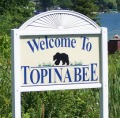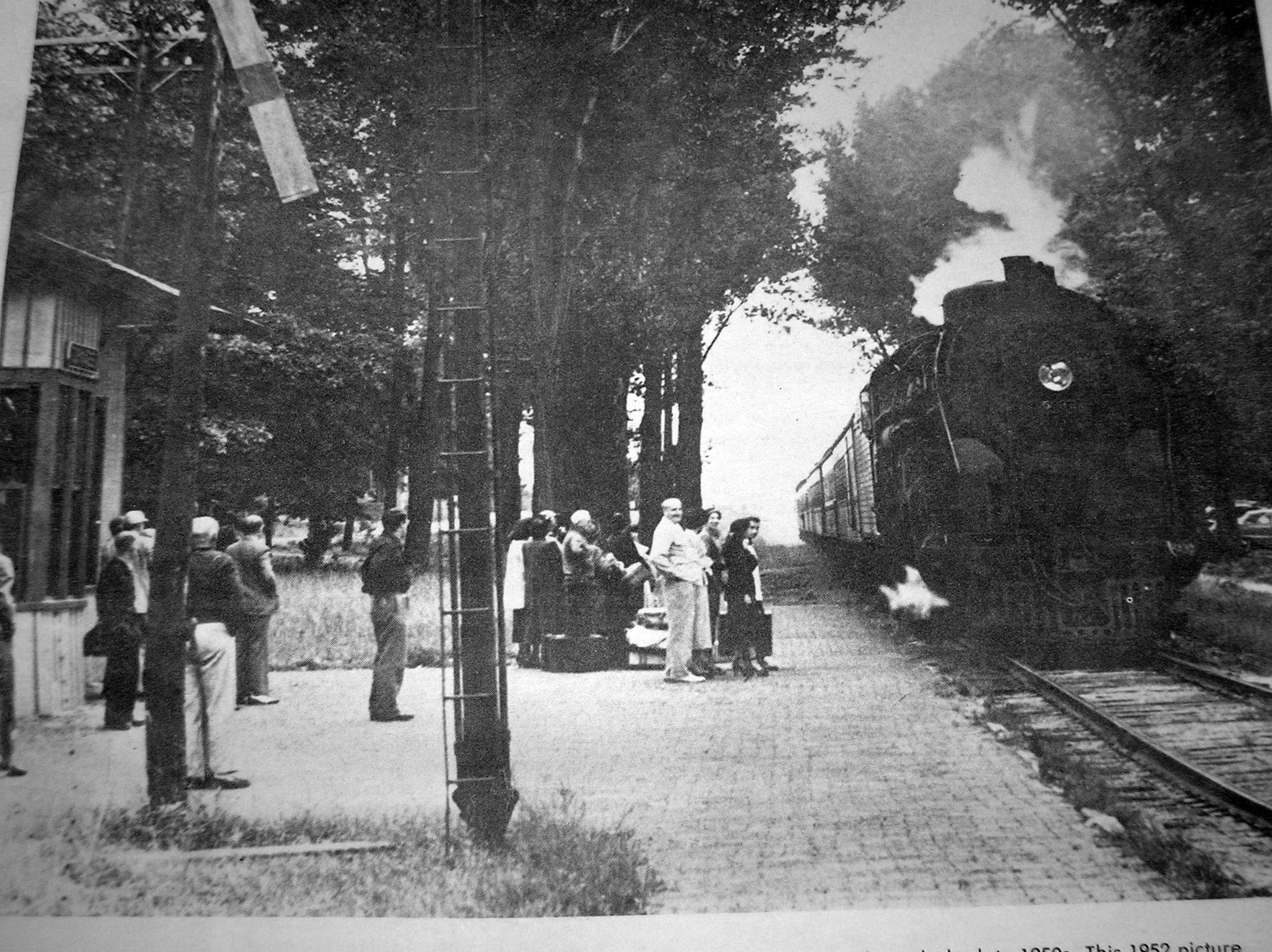Beth and the Railroads
THE RAILROAD
The Michigan Central Railroad, a branch of the New York Central, ran from Detroit to Mackinaw City and had depots all along the way. Our Topinabee depot had a large area of land with it which went at least two blocks along the tracks. There was more land one-half mile south where the Section Master’s home was located. It was on the lake side next to the railroad. There was a siding from there up to the depot where they would take off the freight trains for the passenger trains to pass. When I was small the depot was open all year. About the time I turned 6 or 7 we had only a summer Station Agent. The depot was large building painted greenish beige with a dark green trim. It had a well house at one end of the platform and an artisan well at the other side where many people in town got their drinking water. The railroad station itself had a baggage room on the south end. The next room north was the waiting room with the old fashioned benches with iron dividers. There was a pot belly stove in there and the ticket agent’s window was on the north side of the room. There were two doors on it – one on the front and one on the back. The ticket agent had a fair sized room in the middle. He had a telegraph connection there for sending telegrams and keeping track of the trains. The local people could send and receive telegrams there. The north end of the building was an empty large room; approximately the size of the waiting room and when the summer agent was there he usually lived in that section. There was no plumbing in the building. They would have to use the outhouse at the south end of the platform. One summer the agent brought his whole family with him because there was an epidemic of polio down in Detroit. So there were about 6 people living in that room. They had it divided by putting up ropes and hanging sheets between sections. There was a well house at the south end of the platform. The Station Agent filled 5 gallon carboys and loaded them on a freight car on the siding. The water was used throughout the New York Central System. There used to be a water bottling company called Sanitis Spring. We as kids used the station to play Ante-1-Over and it didn‘t seem to bother the Station Agent much. On the north side of the station platform was a park with a garden which was landscaped every year by the railroad gardeners. The garden is still there. It has a circle in the center and it was squared off with cement posts and pipes and the kids in the village used it to tumble around on the pipes. There was another section of the park that had a baseball diamond and in the spring everybody played – the adults as well as the kids. Mr. Kennedy, the owner of the other store in Topinabee, organized the games and everybody wanted to be on his team. On the very north end of town was a grove of beech trees and every summer there was an oriole family living there. It was the only time I’d seen the hanging oriole nest. They came every summer for years. I suppose it got too congested with cars and they left. Close to the south end of the siding there was a large scale near the Mail Route Road where the railroad would put off the coal cars. Clem Connors, a local contractor, would come down and put his truck on the scale and weigh the amount of coal someone had ordered and then he delivered it. My father ordered the coal every year from the Hopkins coal mine in Ohio. The Hopkins had the cottage on the beach between the Ashman and the Bindley cottages which is presently owned by the McPhersons. The railroad owned the beach in front of the park. It included a large, permanent picnic table where my mother would serve Sunday picnic dinner in the summertime quite frequently – much to my father’s disgust but it didn’t stop her. The beach was public and anyone could use it. Directly in front of the station on the lake side of the tracks was a dance hall and the Vorce family ran it for some time but eventually it was taken over by the hotel and a live band would come every summer to the hotel and play Wednesday and Saturday nights. All the kids would sit on the bank of the railroad bed and we could look through the windows and watch everybody dance and listen to the music. Our folks would let us stay up until the night train came on those nights. Topinabee in the 1980’s but it was there a long time. There was a dock next to the willow tree. One summer we sat on that dock at night and watched a huge forest fire in Presque Isle County. It was a tremendous fire which closed the roads and burned for about a month. On the north beach we didn’t usually swim because it was a clay bed but we used to take the clay out of the lake and use it for modeling. For most of the 1920’s there were four passenger trains a day serving Topinabee- two going north and two going south. The morning train was met by everybody that was up. It brought in the papers from Detroit and the mail for the day. It arrived around 7-7:30 AM and you would hear it whistle when it went around Grandview Beach and that was the signal for everyone to run down to the station. The noon train, southbound, was the one we took when we went to the doctor in Wolverine or to the dentist in Gaylord. The second northbound train brought us home around 4 PM so we weren’t gone the entire day. Most people didn’t have cars in those days and traveled on the train. The night train left between 11and 11:30 and most people going to Detroit took it and slept. It had a couple of Pullman cars on it for the resorters in the summertime. The railroad also ran excursion trains on Friday nights north and Sunday nights south. A lot of families stayed for the summer and the fathers came up Fridays and went down on Sundays. They ran the excursion trains even after the other passenger trains had stopped running. There were also two regular freights a day -one north and one south – and often there were extra freights and that’s when the siding got used the most. The passenger trains stopped running many years ago as people used the improved highways to come and go. The freights held on until the 1990’s when they were discontinued and the steel rails were pulled up to make room for the trail that now runs on the old railroad right of way. ABOUT THE AUTHOR Beth Chamberlin was named Margaret B. Chamberlin at her birth in 1919 as the 7th child and 6th girl born to Ernest C. and Grace Chamberlin. The Chamberlin family moved to Topinabee in 1912 from Mackinac City. Ernest operated a country store in Topinabee—The Chamberlin General Store–until his death in 1942. Beth grew up in Topinabee and attended the one room Mullett Township school house before going to high school in Cheboygan. She graduated from Western Michigan University in Kalamazoo in 1941. Returning to Topinabee she taught at the Wolverine School for one year before going to Ferndale to work in a war plant for one year. This was followed by a three year stint in the Marine Corps. Beth returned to Topinabee in 1984 at 75 years of age to care for her two oldest sisters Florence and Fern and has remained in the village ever since. In between she was employed by the University of Michigan medical school and, after retirement, lived for 15 years in Arizona. Beth’s Memories of Topinabee in the 20’s were tape recorded in the summer of 2008 by Babs Naylor who transcribed the history into several installments, This being the first of a series, for appearance in MAPS Newsletters. Beth gave her permission to Babs Naylor for the publication by MAPS of her memoir..




